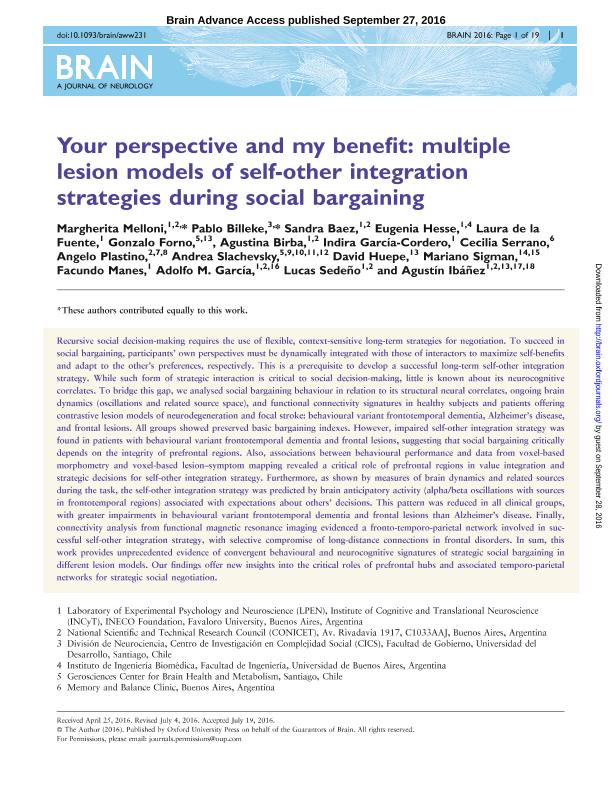Artículo
Your perspective and my benefit: multiple lesion models of self-other integration strategies during social bargaining
Melloni, Margherita ; Billeke, Pablo; Báez Buitrago, Sandra Jimena
; Billeke, Pablo; Báez Buitrago, Sandra Jimena ; Hesse Rizzi, Eugenia Fátima
; Hesse Rizzi, Eugenia Fátima ; de la Fuente de la Torre, Laura Alethia
; de la Fuente de la Torre, Laura Alethia ; Forno, Gonzalo; Birba, Agustina
; Forno, Gonzalo; Birba, Agustina ; García Cordero, Indira Ruth
; García Cordero, Indira Ruth ; Serrano, Cecilia; Plastino, Ángel Luis
; Serrano, Cecilia; Plastino, Ángel Luis ; Slachevsky, Andrea; Huepe, David; Sigman, Mariano
; Slachevsky, Andrea; Huepe, David; Sigman, Mariano ; Manes, Facundo Francisco
; Manes, Facundo Francisco ; García, Adolfo Martín
; García, Adolfo Martín ; Sedeño, Lucas
; Sedeño, Lucas ; Ibañez, Agustin Mariano
; Ibañez, Agustin Mariano
 ; Billeke, Pablo; Báez Buitrago, Sandra Jimena
; Billeke, Pablo; Báez Buitrago, Sandra Jimena ; Hesse Rizzi, Eugenia Fátima
; Hesse Rizzi, Eugenia Fátima ; de la Fuente de la Torre, Laura Alethia
; de la Fuente de la Torre, Laura Alethia ; Forno, Gonzalo; Birba, Agustina
; Forno, Gonzalo; Birba, Agustina ; García Cordero, Indira Ruth
; García Cordero, Indira Ruth ; Serrano, Cecilia; Plastino, Ángel Luis
; Serrano, Cecilia; Plastino, Ángel Luis ; Slachevsky, Andrea; Huepe, David; Sigman, Mariano
; Slachevsky, Andrea; Huepe, David; Sigman, Mariano ; Manes, Facundo Francisco
; Manes, Facundo Francisco ; García, Adolfo Martín
; García, Adolfo Martín ; Sedeño, Lucas
; Sedeño, Lucas ; Ibañez, Agustin Mariano
; Ibañez, Agustin Mariano
Fecha de publicación:
11/2016
Editorial:
Oxford University Press
Revista:
Brain
ISSN:
0006-8950
Idioma:
Inglés
Tipo de recurso:
Artículo publicado
Clasificación temática:
Resumen
Recursive social decision-making requires the use of flexible, context-sensitive long-term strategies for negotiation. To succeed in social bargaining, participants' own perspectives must be dynamically integrated with those of interactors to maximize self-benefits and adapt to the other's preferences, respectively. This is a prerequisite to develop a successful long-term self-other integration strategy. While such form of strategic interaction is critical to social decision-making, little is known about its neurocognitive correlates. To bridge this gap, we analysed social bargaining behaviour in relation to its structural neural correlates, ongoing brain dynamics (oscillations and related source space), and functional connectivity signatures in healthy subjects and patients offering contrastive lesion models of neurodegeneration and focal stroke: behavioural variant frontotemporal dementia, Alzheimer's disease, and frontal lesions. All groups showed preserved basic bargaining indexes. However, impaired self-other integration strategy was found in patients with behavioural variant frontotemporal dementia and frontal lesions, suggesting that social bargaining critically depends on the integrity of prefrontal regions. Also, associations between behavioural performance and data from voxel-based morphometry and voxel-based lesion-symptom mapping revealed a critical role of prefrontal regions in value integration and strategic decisions for self-other integration strategy. Furthermore, as shown by measures of brain dynamics and related sources during the task, the self-other integration strategy was predicted by brain anticipatory activity (alpha/beta oscillations with sources in frontotemporal regions) associated with expectations about others' decisions. This pattern was reduced in all clinical groups, with greater impairments in behavioural variant frontotemporal dementia and frontal lesions than Alzheimer's disease. Finally, connectivity analysis from functional magnetic resonance imaging evidenced a fronto-temporo-parietal network involved in successful self-other integration strategy, with selective compromise of long-distance connections in frontal disorders. In sum, this work provides unprecedented evidence of convergent behavioural and neurocognitive signatures of strategic social bargaining in different lesion models. Our findings offer new insights into the critical roles of prefrontal hubs and associated temporo-parietal networks for strategic social negotiation.
Archivos asociados
Licencia
Identificadores
Colecciones
Articulos(OCA HOUSSAY)
Articulos de OFICINA DE COORDINACION ADMINISTRATIVA HOUSSAY
Articulos de OFICINA DE COORDINACION ADMINISTRATIVA HOUSSAY
Articulos(SEDE CENTRAL)
Articulos de SEDE CENTRAL
Articulos de SEDE CENTRAL
Citación
Melloni, Margherita; Billeke, Pablo; Báez Buitrago, Sandra Jimena; Hesse Rizzi, Eugenia Fátima; de la Fuente de la Torre, Laura Alethia; et al.; Your perspective and my benefit: multiple lesion models of self-other integration strategies during social bargaining; Oxford University Press; Brain; 139; 11; 11-2016; 3022-3040
Compartir
Altmétricas



